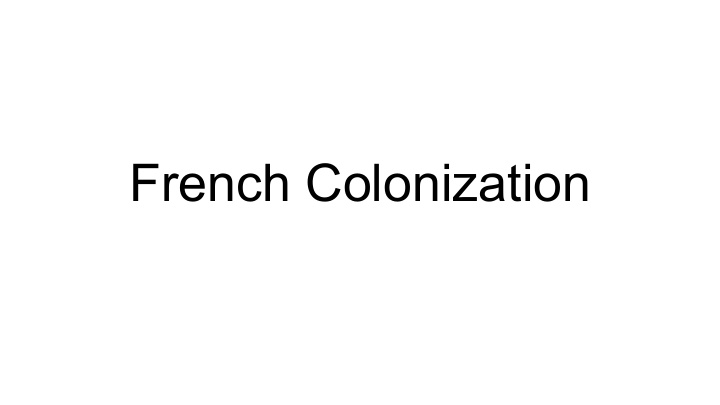



French Colonization
Agenda & Objectives Today we’re going to learn about: - Where and how the French colonized North America - What life was like in New France Objectives: - Examine the motivations of French colonization - Describe life in New France
Where French largely colonized the St. Lawrence river, eventually leading all the way down to Louisiana!
When The first successful colony was established by Samuel de Champlain in 1608. This colony is Quebec City!
Why The French really came for the three Fs: - Fish - Fur - Friends The French were really only here to make a quick buck through trade.
Why Like all other colonizers, they wanted to convert the Natives to Christianity. French priests called Jesuits tried this will limited success at first.
Who and how The French needed people to settle in North America and had a hard time attracting people. To attract people, they set up the “seigneurial system”, where people could get free land!
Seigneurial System In the seigneurial system, a seigneur (a landlord) would get people to settle and farm near a river, called “habitants”. Habitants had to clear the land and farm, giving some of their crops to the seigneur as rent.
Effects for Indigenous Peoples All that farming required a lot of land. However, it still wasn’t as bad as the English. Generally speaking, Indigenous people liked the French more because they realized they were not interested in taking as much land as the English.
Effects for Indigenous Peoples In fact, the French were very interested in making allies with the Natives. Champlain first entered New France into a war between Algonquin, Montagnais, and other Algonquian speaking groups against the Iroquois. For nearly 100 years, there would be on and off warfare for all the parties involved.
Great Peace of Montreal In 1701, the warring “It is with extreme joy that I see all my children assembled here now, you stopped with the Great Hurons, Sable Odawas, Kiskakons, Peace of Montreal. Sinago Odawas, [Odawas] nation of the Fork, [Ojibwas], Potawatomis, Sauks, Puants [...] Abenakis, and you Here is the speech given by the Iroquois nations; having one and the Governor (leader) of all place your interests in my hands New France -> that I can have you all live in tranquility, I therefore today ratify the peace agreement that we have made...
Great Peace of Montreal “As I am determined that there be no more talk of the attacks made during the war, and I gather up again all your hatchets, and all your other instruments of war, which I place with mine in a pit so deep that no one can take them back to disturb the tranquility that I have re-established among my children, and I recommend to you when you meet to treat each other as brothers, and make arrangements for the hunt together so that there will be no quarrels among you .... I attach my words to the collars I will give to each one of your nations so that the elders may have them carried out by their young people, I invite you to smoke, and to eat meat and broth that I have prepared for you so that I have like a good father the satisfaction of seeing all my children united.”
What strikes you about this passage?
Big idea Like all nations, France had a unique way of colonizing. France only came to North America to trade with Indigenous people here. This made them more liked by Indigenous peoples. Largely the relationship between Indigenous Peoples and French were characterized by cooperation opposed to conflict.
Recommend
More recommend